Have you stopped beating your wife yet?
I'm fine with the revolution, but it does very little when dealing with preventing the collapse from the overshoot of the carrying capacity of the global ecosystem. Read the fine paper, your attitude is in line with what it describes.
Strange. It works for me. Can anyone else reproduce the error?
I don't believe that we've very significantly overshot our global ecosystem carrying capacity. Especially post-fossil. It's a fact outlined in many numbers in thousands of peer reviewed publications.
As to what we could collectively do: sadly, very little. The overall system has almost no degrees of freedom left. You're mostly down to personal and community scale choices. Small things.
Not going to continue to discuss that here though.
We are not making anyone move. I and the rest of the mods but wabooti who is MIA for 8 months have already left. It's a courtesy notice to the community. Whether wabooti will continue is up to him. I will just stay here long enough for the discussion, if any.
You can of course make your own collapse community (with blackjack and hookers) but perhaps pick an instance where the admins are not overshoot deniers. It seems though you don't quite understand the significance of that "slap on the wrist".
Thank you for confirming the core point of the paper.
Admin Removed Post Overshoot: Cognitive obsolescence and the population conundrum [PDF] reason: promotes eugenics
which also got me a 3-day site wide ban for "promoting eugenics" which is no longer showing up since expired.
In general admins can of course remove users and communities for reasonable reasons, but editor decisions on communitity content (even those I don't feel strong about) are strange.
My pleasure. Obviously a community discussing collapse can't stay in a place which denies overshoot of the ecosystem carrying capacity. The Reese paper doesn't say a thing about eugenics.
Because of admin interference with the content https://lemmy.ml/modlog/16033 and disciplinary actions we obviously can't stay here.
We've set up shop on http://lemm.ee/c/collapse !collapse@lemm.ee so please update your subscription if you intend to continue to follow this community.
At some point this community will be mothballed, unless wabooti@lemmy.ml wants to continue taking care of it.
We are not going to abandon fossil fuels. However, fossil fuels are abandoning us. And those 8.1 billion and counting will be going away, too.
We all want solutions to the world's many crises but do we understand the underlying problems? Everything in nature, including human society, relies on energy for production, consumption, recycling, and sustainability. Therefore, to understand things, we must first examine how energy is turned into ...

THE REALITY OF EXTEND-AND-PRETEND The great unspoken fact of the 1930s was that the world was drifting to war, a trend that nobody knew how to stop. The great unspoken fact of the 2020s is that the…

Significance
Technological innovation is central to sustainable development, but representing novel technologies in systems models is difficult due to limited data on their past performance. We propose a method to model the feasibility space for novel technologies that combines empirical data on historical analogs and early adoption with a global integrated assessment model. Applying this method to direct air carbon capture and storage (DACCS), we find that the feasibility space is large, with DACCS contributing meaningfully to net-zero goals if it grows like some analogs and failing to do so with others. The results can be used to identify technology and policy features that may be important in enabling rapid adoption to avert the worst effects of climate change.
Abstract
Limiting the rise in global temperature to 1.5 °C will rely, in part, on technologies to remove CO2 from the atmosphere. However, many carbon dioxide removal (CDR) technologies are in the early stages of development, and there is limited data to inform predictions of their future adoption. Here, we present an approach to model adoption of early-stage technologies such as CDR and apply it to direct air carbon capture and storage (DACCS). Our approach combines empirical data on historical technology analogs and early adoption indicators to model a range of feasible growth pathways. We use these pathways as inputs to an integrated assessment model (the Global Change Analysis Model, GCAM) and evaluate their effects under an emissions policy to limit end-of-century temperature change to 1.5 °C. Adoption varies widely across analogs, which share different strategic similarities with DACCS. If DACCS growth mirrors high-growth analogs (e.g., solar photovoltaics), it can reach up to 4.9 GtCO2 removal by midcentury, compared to as low as 0.2 GtCO2 for low-growth analogs (e.g., natural gas pipelines). For these slower growing analogs, unabated fossil fuel generation in 2050 is reduced by 44% compared to high-growth analogs, with implications for energy investments and stranded assets. Residual emissions at the end of the century are also substantially lower (by up to 43% and 34% in transportation and industry) under lower DACCS scenarios. The large variation in growth rates observed for different analogs can also point to policy takeaways for enabling DACCS.
They do get released. I need a source of high quality rips for the NAS to stream from.
Globally, you probably are. It doesn't take that much to qualify. There is a website to check via income.
Too bad we're already over 1.5 C though it will take a decade for it to be official.
Ok, if you don't use their web site you won't see the UX dark patterns. Trust us, they there and fit with the overall garbagefication theme. Annoys the living shit out of me. At least no more Prime Video UI and ad trainwreck.
If you haven't noticed, you've been not paying attention. I canceled Prime a while ago and they try very hard to get you back. And they try to sneak on you billed expedited shipping when over minimum gratis shipping quota. Dark patterns galore.
It would be a major pain for me to boycott them completely so I don't, yet.
How would a national government (not TLAs) target particular individuals in a large number of users and what information can they gather given e.g. https://mullvad.net/en/help/no-logging-data-policy ? So perhaps not quite as easily as ordering a tap.
My national government has no business knowing which protocols I use to contact which endpoints and tamper with that traffic. Wrapping up that information in a tunnel is a good first protection layer.
You forget that nation-states control your ISP. And of course you can choose your VPN provider or run your own.
The provider and national TLAs will see all traffic that is in cleartext and meta traffic which is even more valuable. It can also actively tamper with that traffic. So you're technically incorrect and you assume your threat model is universal. It's not. And, of course, there are use cases for Tor, whether with or without VPN.
Total Solar Irradiance (TSI) quantifies the solar energy received by the Earth and therefore is of direct relevance for a possible solar influence on climate change on Earth. We analyse the TSI space measurements from 1991 to 2021, and we derive a regression model that reproduces the measured daily ...
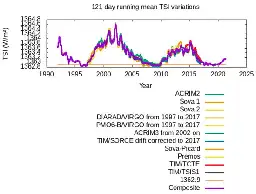
Abstract
Total Solar Irradiance (TSI) quantifies the solar energy received by the Earth and therefore is of direct relevance for a possible solar influence on climate change on Earth. We analyse the TSI space measurements from 1991 to 2021, and we derive a regression model that reproduces the measured daily TSI variations with a Root Mean Square Error (RMSE) of 0.17 W/m2. The daily TSI regression model uses the MgII core to wing ratio as a facular brightening proxy and the Photometric Sunspot Index (PSI) as a measure of sunspot darkening. We reconstruct the annual mean TSI backwards to 1700 based on the Sunspot Number (SN), calibrated on the space measurements with an RMSE of 0.086 W/m2. The analysis of the 11 year running mean TSI reconstruction confirms the existence of a 105 year Gleissberg cycle. The TSI level of the current grand minimum is only about 0.15 W/m2 higher than the TSI level of the grand minimum in the beginning of the 18th century.
Keywords: total solar irradiance; sunspot number
We find that so-called “sustainable” aviation fuels are largely a false solution.

Including an exceptionally warm Northern Hemisphere (NH) summer1,2, 2023 has been reported as the hottest year on record3-5. Contextualizing recent anthropogenic warming against past natural variability is nontrivial, however, because the sparse 19th century meteorological records tend to be too war...
An evolutionary biologist and a science fiction writer walk into a bar... and mull over survival.

Recently I have been on a four-day hiking trip, completing another 80 km (~50 mile) stretch of the 1171 km National Blue Trail running across my tiny country. This gave me plenty of time to tune into and ponder on the many podcasts I downloaded previously, but never had the time to listen to.

Stratocumulus cloud decks—which cool the Earth’s surface by shading it from sunlight, and are prevalent in the subtropics—break up into scattered clouds when CO2 levels rise above 1,200 ppm in large-eddy simulations that explicitly resolve cloud dynamics.
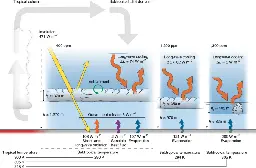
Abstract
Stratocumulus clouds cover 20% of the low-latitude oceans and are especially prevalent in the subtropics. They cool the Earth by shading large portions of its surface from sunlight. However, as their dynamical scales are too small to be resolvable in global climate models, predictions of their response to greenhouse warming have remained uncertain. Here we report how stratocumulus decks respond to greenhouse warming in large-eddy simulations that explicitly resolve cloud dynamics in a representative subtropical region. In the simulations, stratocumulus decks become unstable and break up into scattered clouds when CO2 levels rise above 1,200 ppm. In addition to the warming from rising CO2 levels, this instability triggers a surface warming of about 8 K globally and 10 K in the subtropics. Once the stratocumulus decks have broken up, they only re-form once CO2 concentrations drop substantially below the level at which the instability first occurred. Climate transitions that arise from this instability may have contributed importantly to hothouse climates and abrupt climate changes in the geological past. Such transitions to a much warmer climate may also occur in the future if CO2 levels continue to rise.
The average global temperature for each of the past eleven months has been the hottest the world has experienced in that month.

Abstract and Figures
Rapid warming in the Arctic has the potential to release vast reservoirs of carbon into the atmosphere as methane (CH4) resulting in a strong positive climate feedback. This raises the concern that, after a period of near-zero growth in atmospheric CH4 burden from 1999 to 2006, the increase since then may be in part related to increased Arctic emissions. Measurements of CH4 in background air samples provide useful, direct information to determine if Arctic CH4 emissions are increasing. One sensitive first-order indicator for large emission change is the Interpolar Difference, that is the difference in surface atmospheric annual means between polar northern and southern zones (53°–90°), which has varied interannually, but did not increase from 1992 to 2019. The Interpolar Difference has increased moderately during 2020–2022 when the global CH4 burden increased significantly, but not yet to its peak values in the late-1980s. For quantitative assessment of changing Arctic CH4 emissions, the atmospheric measurements must be combined with an atmospheric tracer transport model. Based on multiple studies including some using CH4 isotopes, it is clear that most of the increase in global atmospheric CH4 burden is driven by increased emissions from microbial sources in the tropics, and that Arctic emissions have not increased significantly since the beginning of our measurement record in 1983 through 2022.
The state is home to the data center capital of the world. Can it handle AI's thirst?
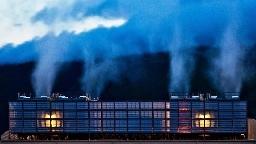
The Paleocene–Eocene boundary coincided with runaway global warming possibly analogous to future climate change, but the sources of greenhouse gasses have remained unresolved. Here, the authors reveal volcanism triggered initial warming, and subsequent carbon was released after crossing a tipping po...
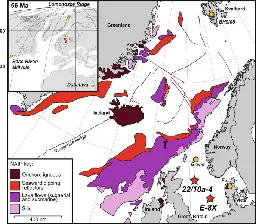
Abstract
The Paleocene–Eocene Thermal Maximum (PETM) was a period of geologically-rapid carbon release and global warming ~56 million years ago. Although modelling, outcrop and proxy records suggest volcanic carbon release occurred, it has not yet been possible to identify the PETM trigger, or if multiple reservoirs of carbon were involved. Here we report elevated levels of mercury relative to organic carbon—a proxy for volcanism—directly preceding and within the early PETM from two North Sea sedimentary cores, signifying pulsed volcanism from the North Atlantic Igneous Province likely provided the trigger and subsequently sustained elevated CO2. However, the PETM onset coincides with a mercury low, suggesting at least one other carbon reservoir released significant greenhouse gases in response to initial warming. Our results support the existence of ‘tipping points’ in the Earth system, which can trigger release of additional carbon reservoirs and drive Earth’s climate into a hotter state.
Demonstration of high performance, upscaling and integration of ultra-lightweight perovskite solar cells are still rare. Hailegnaw et al. develop 2D perovskite solar cells based on methylbenzyl ammonium iodide with improved specific power and stability, showing scalability and integration in drones.
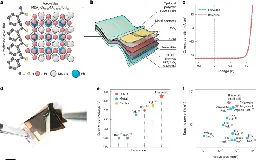
Abstract
Perovskite solar cells are a promising technology for emerging photovoltaic applications that require mechanical compliance and high specific power. However, the devices suffer from poor operational stability. Here we develop lightweight, thin (<2.5 μm), flexible and transparent-conductive-oxide-free quasi-two-dimensional perovskite solar cells by incorporating alpha-methylbenzyl ammonium iodide into the photoactive perovskite layer. We fabricate the devices directly on an ultrathin polymer foil coated with an alumina barrier layer to ensure environmental and mechanical stability without compromising weight and flexibility. We demonstrate a champion specific power of 44 W g−1 (average: 41 W g−1), an open-circuit voltage of 1.15 V and a champion efficiency of 20.1% (average: 18.1%). To show scalability, we fabricate a photovoltaic module consisting of 24 interconnected 1 cm2 solar cells and demonstrate energy-autonomous operation of a hybrid solar-powered quadcopter, while constituting only 1/400 of the drone’s weight. Our performance and stability demonstration of ultra-lightweight perovskite solar cells highlight their potential as portable and cost-effective sustainable energy harvesting devices.